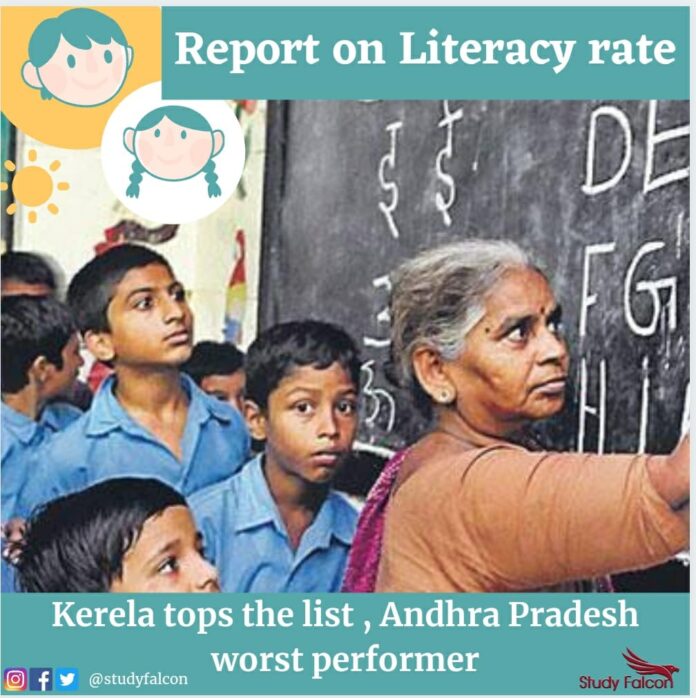Recently, the report on ‘Household Social Consumption: Education in India as part of 75th round of National Sample Survey – from July 2017 to June 2018’ has been released.
It is based on the National Statistical Office (NSO) survey and provides for state-wise detail of literacy rate among the persons aged seven years and above. The report comes before the International Literacy Day which is celebrated on 8th September every year.
With 96.2 per cent literacy, Kerala has once again emerged as the most literate state in the country, while Andhra Pradesh featured at the bottom with a rate of 66.4 per cent, showed a report based on National Statistical Office (NSO) survey. Delhi has the best literacy rate at 88.7 per cent, followed by Uttarkhand’s 87.6 per cent, Himachal Pradesh’s 86.6 per cent and Assam’s at 85.9 per cent.

Rajasthan is the second worst performer with literacy rate at 69.7 per cent, followed by Bihar at 70.9 per cent, Telangana at 72.8 per cent, Uttar Pradesh at 73 per cent and Madhya Pradesh at 73.7 per cent.
The study has pegged the overall literacy rate in the country at about 77.7 per cent. In rural areas, the literacy rate is 73.5 per cent compared to 87.7 per cent in urban areas of the country.
At all-India level, the male literacy rate is higher at 84.7 per cent compared to 70.3 per cent among women.
The survey showed that the male literacy rate is higher than female literacy rate among all states. In Kerala, the male literacy rate is 97.4 per cent compared to 95.2 per cent among females. The male literacy rate in Delhi stood a 93.7 per cent higher than 82.4 per cent among females. In Andhra Pradesh, male literacy rate is 73.4 per cent, higher than 59.5 per cent among females In Rajasthan, the gap was even wider as male literacy rate stood at 80.8 per cent compared to 57.6 per cent of females. In Bihar, the male literacy rate was also higher at 79.7 per cent compared to 60.5 per cent of females.
Among persons of age 15-29 years, nearly 24 per cent in rural areas and 56 per cent in urban areas were able to operate a computer. Nearly 35 per cent of persons of age 15-29 years reported use of internet during the 30 days prior to the date of survey. The proportions were nearly 25 per cent in rural areas and 58 per cent in urban areas.

How India calculates literacy rate
Literacy rate is calculated by dividing the number of literates in a given age range by the corresponding age group population The result is then multiplied by 100. The same method can be applied to calculate the number of illiterates; or by subtracting the literacy rate from 100%.
As per the 2011 Census, any person aged seven and above and has the ability to readand write is considered literate.

International Literacy Day 2020
The importance of literacy was first observed at the United Nations Educational, Scientific and Cultural Organisation’s (UNESCO) General conference in 1966 and following this, the first International Literacy Day was celebrated on 8th September 1967 and the tradition has been held annually since then.
Objective: To raise awareness and remind people of the importance of literacy as a matter of dignity and human rights.
Literacy Day 2020: It will focus on the changes and challenges in learning during the Covid-19 pandemic.
It will reflect on the innovative and effective pedagogies that can be used in youth and adult literacy programmes to face the pandemic and beyond.
The international community is focusing on 2030 with Sustainable Development Goals (SDGs) and has aimed to “ensure inclusive and quality education for all and promote lifelong learning” within its goals of SDG 4.
The 50-year review of South Asia (which includes Bangladesh, India, Islamic Republic of Iran, Nepal and Pakistan) states that the large scale illiteracy is ever-present among adults.
As per UNESCO, India will achieve universal literacy by 2060.










